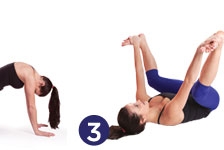
Gridlock, stalls, accidents, unpredictable drivers—we encounter many stressors on a typical daily commute. Many of us would prefer a leisurely walk to and from work; however, for those who take a long daily drive or public transit ride, a few helpful strategies can bring calm to your commute.
Breathe
In a yoga class you may be invited to bring your practice off your mat and into your life. The daily commute, too, provides an opportunity to do this. Breathing practices, yoga movements and being mindful are three great ways to bring some calm into your commute.
We are always breathing; however, in times of stress our breathing often becomes shallow, resulting in headache, fatigue, insomnia, muscle stiffness and more. Bringing awareness to the breath to deepen it can help you to relax during your commute.
Five-count breath
Even before you notice feelings of stress during your commute, try a simple five-count breath. Close your mouth and keep your jaw relaxed. Breathe in through your nose for a count of five. Feel the air moving into your nose and filling up your chest. Use your diaphragm to slowly exhale for a count of five. Try to completely fill and empty your lungs when doing this breathing technique. Repeat three to five times. This type of breathing is also effective when you do notice stress building within yourself.
Letting go breath
Try this one if you notice you are starting to feel stressed during your commute. Breathe in for a count of three through your nose and then exhale forcefully through your mouth, making an audible huffing sound. Imagine you are letting go of your stress while you exhale. Repeat a second or third time.
Yoga movements
Bring some small yoga-inspired movements into your daily commute when it is not a distraction. You can do these movements before or after your drive or when you are at a complete stop. For those on public transport, these actions can be taken any time.
Neck and shoulders
Make a habit of using time stopped in traffic to bring some movement into your body. Try rotating your head slowly from left to right, like you are motioning “no”. On an inhalation bring your head to centre and move your head to the side during your exhalation. Repeat on each side. Now bring your chin down to your chest and then back up to a neutral position. If you feel any tension in a particular spot, pause your movement and take a few breaths there to invite some relaxation into that spot.
You can also bring your shoulders up to your ears and then roll them down and back, squeezing your shoulder blades together. Repeat this at least 10 times.
Tense and release
Invite some tension into a part of your body and then restore relaxation to that part of your body. For example, bring tension into your fingers for a count of three and then enjoy the sensation of relaxing all those little muscles. Now try your forearms, upper arms, toes, calves and upper legs in succession.
Be mindful
Mindfulness is an awareness of your internal state in each moment. Tuning in to how you are feeling is an important part of managing stress.
Body scan
Take a mental scan of various parts of your body. Start by checking in with your head. Is your jaw relaxed or are you holding tension there? Release some tension by making some gentle movements to your jaw. Continue down your body and check in with your neck, back, arms, legs, core and fingers and toes. Bring slow, conscious movement to any part of your body that feels tense. If you are driving, pay particular attention to how you are holding the steering wheel. Are you gripping the wheel tightly or is your body relaxed?
Reflection
Take stock of all the reasons you go to work. You might want to write these down to remember them. Practising the gratitude response is a powerful habit to develop.
Music
Instead of listening to the radio and traffic reports, try listening to calming music during your commute. Your library and health food store probably carry a number of guided relaxation CDs as well.
Outside of the car or public transit
Here is a simple routine of three familiar poses for before or after your commute.

1. Triangle pose
Stand up tall, feet wide and arms extended to the sides. Inhale and pivot your left foot to the left so your left foot is now perpendicular to your right. Exhale and reach your left hand down to your left leg or ankle, or the floor. Reach your right hand up high to the ceiling. Keep a small bend in your knees. Inhale and exhale five times in this pose. Repeat on other side.
2. Cat and cow
On your hands and knees, align your wrists under your shoulders and your knees under your hips. Inhale and drop your belly as you look up towards the ceiling. As you exhale, round your back, tucking your chin into your chest. Repeat three times.
3. Happy baby pose
Begin by lying down on your back. Hug your knees into your chest. Flex your feet and hold them in your hands with your shins perpendicular to the mat or floor. Breathe here for at least one minute.
Supplements for commuters
Reduce stress levels with these supplements.
Omega-3s: In a recent double-blind, placebo-controlled trial, men who were chronically stressed experienced stress-reducing effects with omega-3s in phosphatidylserine.
Rhodiola: This herbal adaptogen is often used to reduce stress and stress-associated conditions such as anxiety and irregular heartbeat.
Ginseng: Also an adaptogen, Asian ginseng (Panax ginseng) has been shown to improve quality of life by improving sleep, energy and overall well-being.
Camomile: One of the most popular herbs in the Western world, camomile helps to calm anxiety, thereby reducing stress.
Consult your health care practitioner or the knowledgeable staff at your local natural health retailer before taking new supplements.




